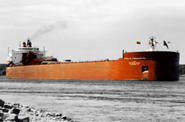Logistics

December 20, 2020
Great Lakes Shipping Ends Year Strong, Despite the Pandemic
Written by Sandy Williams
November was a busy month for ports on the Great Lakes and St. Lawrence Seaway as businesses stockpiled year-end inventory prior to the closure of the 2020 shipping season. The Great Lakes Seaway Partnership reports international trade of agriculture and wind turbine components remained steady last month, while steel shipments increased.
“As the 2020 Seaway navigation season heads into its final few weeks, we are encouraged by the amount of activity at our ports,” said Craig H. Middlebrook, Deputy Administrator of the U.S. Saint Lawrence Seaway Development Corporation. “Even though total tonnage is still not at last year’s levels for this time of year, the number of vessels transiting the Great Lakes Seaway System is significant.”
Overall tonnage on the Great Lakes-St. Lawrence Seaway system was down just 6.6 percent compared to a year ago, despite the challenges of a pandemic and economic recession. From April 1 through Nov. 30, 2020, American and Canadian ports handled a total of 32.3 million metric tons of cargo compared to 34.5 million ton during the same period in 2019.
Combined U.S. and Canadian commodity volumes increased significantly during the year, with grain volumes up 23.2 percent, gypsum up 31.1 percent , asphalt up 45.7 percent and steel slab shipments more than doubling at 127.9 percent. The ports on the Great Lakes and Seaway system traded with an estimated 40 countries this year.
Project cargo was another positive commodity in 2020. Shipments of turbine components are up 57 percent year-to-date, said the Chamber of Marine Commerce. The Port of Duluth especially benefitted from wind energy cargo this year, welcoming its final inbound shipment in late November for a single season record of 525,000 tons. The port was visited by 30 ships from eight countries, which provided parts for over 150 wind turbines in North Dakota and South Dakota.
Iron ore was a less fortunate commodity this year. Trade on the Great Lakes fell 10 percent in November to 4.25 million tons, said the Lake Carriers’ Association. Year-to-date iron ore loadings plummeted 24.8 percent to 36.6 million tons as the pandemic cut into steel demand during the first half of the year. Iron ore loadings were 22.5 percent below their five-year average.
Ports and carriers on both sides of the border were optimistic about the coming year.
“The last quarter of the year has been progressively trending upward. From a tonnage standpoint, our cargo continues to be diversified, which was one of our main goals,” said Dave Gutheil, Chief Commercial Officer, Port of Cleveland. “We have seen some new cargos into Cleveland within the last two months, and we expect that to continue before the end of the season in 2020.”
“As we look ahead to 2021, we’re cautiously optimistic,” said Julie Lambert, Vice-President, Commercial, for Montreal-based Canada Steamship Lines. “We expect our fleet to be fully booked and are seeing strong demand for grain shipments at the start of the season. We also expect to see greater market stability and improved economic conditions next year, as companies have implemented effective measures to deal with COVID-19 and, with the arrival of vaccines, we expect to see a decrease in infection rates.”







